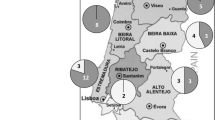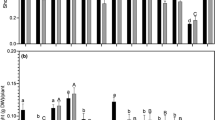Abstract
Plant growth-promoting rhizobacteria are bacteria that improve plant growth and reduce plant pathogen damages. In this study, 100 nodule bacteria were isolated from chickpea, screened for their plant growth-promoting (PGP) traits and then characterised by PCR-RFLP of 16 S rDNA. Results showed that most of the slow-growing isolates fixed nitrogen but those exhibiting fast-growth did not. Fourteen isolates solubilized inorganic phosphorus, 16 strains produced siderophores, and 17 strains produced indole acetic acid. Co-culture experiments identified three strains having an inhibitory effect against Fusarium oxysporum, the primary pathogenic fungus for chickpea in Tunisia. Rhizobia with PGP traits were assigned to Mesorhizobium ciceri, Mesorhizobium mediterraneum, Sinorhizobium meliloti and Agrobacterium tumefaciens. We noted that PGP activities were differentially distributed between M. ciceri and M. mediterraneum. The region of Mateur in northern Tunisia, with clay–silty soil, was the origin of 53% of PGP isolates. Interestingly, we found that S. meliloti and A. tumefaciens strains did not behave as parasitic nodule-bacteria but as PGP rhizobacteria useful for chickpea nutrition and health. In fact, S. meliloti strains could solubilize phosphorus, produce siderophore and auxin. The A. tumefaciens strains could perform the previous PGP traits and inhibit pathogen growth also. Finally, one candidate strain of M. ciceri (LL10)—selected for its highest symbiotic nitrogen fixation and phosphorus solubilization—was used for field experiment. The LL10 inoculation increased grain yield more than three-fold. These finding showed the potential role of rhizobia to be used as biofertilizers and biopesticides, representing low-cost and environment-friendly inputs for sustainable agriculture.




Similar content being viewed by others
Data availability
The datasets generated during and/or analysed during the current study are available from the corresponding author on reasonable request.
References
Adedeji AA, Häggblom MM, Babalola OO (2020) Sustainable agriculture in Africa: plant growth promoting rhizobacteria (PGPR) to the rescue. Sci Afr. https://doi.org/10.1016/j.sciaf.2020.e00492
Ahmad F, Ahmad I, Khan MS (2008) Screening of free-living rhizospheric bacteria for their multiple plant growth promoting activities. Microbiol Res 163:173–181
Alemneh AA, Zhou Y, Ryder MH, Denton MD (2020) Mechanisms in plant growth promoting rhizobacteria that enhance legume–rhizobial symbioses. J Appl Microbiol 129:1133–1156
Alikhani HA, Saleh-Rastin N, Antoun H (2006) Phosphate solubilization activity of rhizobia native to Iranian soils. Plant Soil 287:35–41
Alori ET, Babalola OO (2018) Microbial inoculants for improving crop quality and human health in Africa. Front Microbiol 9:2213
Ansari RA, Mahmood I (2019) Plant Health Under Biotic Stress. Volume 2, Microbial Interactions. Springer, Singapore
Antoun H, Kloepper JW (2001) Plant growth promoting rhizobacteria. In: Brenner S, Miller JH (eds) Encyclopedia of genetics. Academic Inc, New York, pp 1477–1480
Armstrong RA, Hilton AC (2010) Statistical analysis in microbiology: statnotes. Wiley, New Jersey
Barea JM (2015) Future challenges and perspectives for applying microbial biotechnology in sustainable agriculture based on a better understanding of plant-microbiome interactions. J Soil Sci Plant Nutr 15:261–282
Beck DP, Materon LA, Afandi F (1993) Practical Rhizobium-legume technology manual, Technical manual no. 19. International Center for Agricultural Research in the Dry Areas (ICARDA), Aleppo, Syria
Ben Romdhane S, Aouani ME, Mhamdi R (2007a) Inefficient nodulation of chickpea (Cicer arietinum L.) in the arid and Saharan climates in Tunisia by Sinorhizobium meliloti biovar medicaginis. Ann Microbiol 57:15–20
Ben Romdhane S, Tajini F, Trabelsi M, Aouani ME (2007b) Competition for nodule formation between introduced strains of Mesorhizobium ciceri and the native populations of rhizobia nodulating chickpea (Cicer arietinum) in Tunisia. World J Microbiol Biotechnol 23:1195–1201
Ben Romdhane S, Aouani ME, Trabelsi M, De Lajudie P (2009) The diversity of rhizobia nodulating chickpea (Cicer arietinum) under water deficiency as a source of more efficient inoculants. Soil Biol Biochem 41:2568–2572
Benjelloun I, Thami-Alami I, Douira A, Udupa SM (2019) Phenotypic and genotypic diversity among symbiotic and non-symbiotic bacteria present in chickpea nodules in Morocco. Front Microbiol. https://doi.org/10.3389/fmicb.2019.01885
Bouabdellah F, Laouana S (2014) Etude de la solubilisation du phosphate et effet d’antagonisme des bactéries isolées de la légumineuse Cicer arietinum. Dissertation, University of Constantine 1, Algeria
Brígido C, Glick BR, Oliveira S (2017) Survey of plant growth-promoting mechanisms in native portuguese chickpea Mesorhizobium isolates. Microb Ecol 73:900–915
Defez R, Andreozzi A, Romano S, Pocsfalvi G, Fiume I, Esposito R, Angelini C, Bianco C (2019) Bacterial IAA-delivery into medicago root nodules triggers a balanced stimulation of C and N metabolism leading to a biomass increase. Microorganisms 7:403
Fasusi OA, Cruz C, Babalola OO (2021) Agricultural sustainability: microbial biofertilizers in rhizosphere management. Agriculture. https://doi.org/10.3390/agriculture11020163
Gopalakrishnan S, Sathya A, Vijayabharathi R, Varshney RK (2015) Plant growth promoting rhizobia: challenges and opportunities. 3 Biotech 5:355–377
Gravel V, Antoun H, Tweddell RJ (2007) Growth stimulation and fruit yield improvement of greenhouse tomato plants by inoculation with Pseudomonas putida or Trichoderma atroviride: possible role of indole 3 acetic acid (IAA). Soil Biol Biochem 39:1968–1977
Greenlon A, Chang PL, Damtew ZM, Muleta A, Carrasquilla-Garcia N, Kim D, Nguyen HP, Suryawanshi V, Krieg CP, Yadav SK, Patel JS, Mukherjee A, Udupa S, Benjelloun I, Thami-Alami I, Yasin M, Patil B, Singh S, Sarma BK, von Wettberg EJB, Kahraman A, Bukun B, Assefa F, Tesfaye K, Fikre A, Cook DR (2019) Global-level population genomics reveals differential effects of geography and phylogeny on horizontal gene transfer in soil bacteria. PNAS 116(30):15200–15209
Gunnabo AH, van Heerwaarden J, Geurts R, Wolde-meskel E, Degefu T, Giller KE (2021) Phylogeography and symbiotic effectiveness of rhizobia nodulating chickpea (Cicer arietinum L.) in Ethiopia. Microb Ecol 81:703–716
Igiehon NO, Babalola OO (2018) Rizosphere microbiome modulators: contributions of nitrogen fixing bacteria towards sustainable agriculture. Int J Environ Res Public Health 15:574–586
Jha CK, Saraf M (2015) Plant growth promoting rhizobacteria (PGPR): a review. E3. J Agric Res Develop 5:108–119
Joseph B, Patra RR, Lawrence R (2007) Characterization of plant growth promoting rhizobacteria associated with chickpea (Cicer arietinum L.). Int J Plant Prod 2:141–152
Khanna R, Pawar J, Gupta S, Verma H, Trivedi H, Kumar P, Kumar R (2019) Efficiency of biofertilizers in increasing the production potential of cereals and pulses: a review. J pharmacogn phytochem 8(2):183–188
King EO, Ward MK, Raney DE (1954) Two simple media for the demonstration of pyocyanin and fluorescin. J Lab Clin Med 44:301–307
Korbu L, Tafes B, Kassa G, Mola T, Fikre A (2020) Unlocking the genetic potential of chickpea through improved crop management practices in Ethiopia. Agron Sustain Dev 40:1–20
Kumar S, Diksha, Sindhu SS, Kumar R (2022) Biofertilizers: an ecofriendly technology for nutrient recycling and environmental sustainability. CRMICR. https://doi.org/10.1016/j.crmicr.2021.100094
Laguerre G, van Berkum P, Amarger N, Prévost D (1997) Genetic diversity of rhizobial symbionts isolated from legume species within the genera Astragalus, Oxytropis and Onobrychis. Appl Environ Microbiol 63:4748–4758
Nosheen S, Ajmal I, Song Y (2021) Microbes as biofertilizers, a potential approach for sustainable crop production. Sustainability. https://doi.org/10.3390/su13041868
Nosheen A, Yasmin H, Naz R, Keyani R, Mumtaz S, Hussain SB, Hassan MN, Alzahrani OM, Noureldeen A, Darwish H (2022) Phosphate solubilizing bacteria enhanced growth, oil yield, antioxidant properties and biodiesel quality of Kasumbha. Saudi J Biol Sci 29:43–52
Nour SM, Cleyet-Maret JC, Normand P, Fernandez MP (1995) Genomic heterogeneity of strains nodulating chikpeas (Cicer arietinum L.) and description of Rhizobium mediterraneum sp. nov. Int J Syst Bacteriol 45:640–648
Peix A, Rivas-Boyero AA, Mateos PF, Rodríguez-Barrueco C (2001) Growth promotion of chickpea and barley by a phosphate solubilizing strain of Mesorhizobium mediterraneum under growth chamber conditions. Soil Biol Biochem 33:103–110
Raymond NS, Gomez-Munoz B, van der Bom FJT, Nybroe O, Jensen LS, Muller-Stover DS, Oberson A, Richardson AE (2021) Phosphate-solubilising microorganisms for improved crop productivity: a critical assessment. New Phytol 229:1268–1277
Saïdi S, Chebil S, Gtari M, Mhamdi R (2013) Characterization of root-nodule bacteria isolated from Vicia faba and selection of plant growth promoting isolates. World J Microbiol Biotechnol 29:1099–1106
Schwyn B, Neilands JB (1987) Universal chemical assay for the detection and determination of siderophores. Anal Biochem 160:47–56
Sheng XF, Xia JJ, Jiang CY, He LY, Qian M (2008) Characterization of heavy metal-resistant endophytic bacteria from rape (Brassica napus) roots and their potential in promoting the growth and lead accumulation of rape. Environ Pollut 156:1164–1170
Sridevi M, Mallaiah KV (2009) Phosphate solubilization by Rhizobium strains. Indian J Microbiol 49:98–102
Swift R, Denton MD, Melino VJ (2019) Plant probiotics for nutrient acquisition by agriculturally important grasses: A comprehensive review of the science and the application. Annu Plant Rev 2:1–47
Sylvester-Bradley R, Asakawa N, La Torraca S, Magalhaes FMM (1982) Levantamento quantitativo de microrganismos solubilizadores de fosfatos na rizosfera de gramineas e leguminosas forrageiras na Amazônia. Acta Amaz 12:15–22
Vadez V, Rodier F, Payré H, Drevon JJ (1996) Nodule permeability to O2 and nitrogenase-linked respiration in bean genotypes varing in the tolerance of N2 fixation to P deficiency. Plant Physiol Biochem 34:871–878
Verma JP, Yadav J, Tiwari KN, Kumar A (2013) Effect of indigenous Mesorhizobium spp. and plant growth promoting rhizobacteria on yields and nutrients uptake of chickpea (Cicer arietinum L.) under sustainable agriculture. Ecol Eng 51:282–286
Vincent JM (1970) A manual for the practical study of root nodule bacteria, IBP handbook no 15. Blackwell, Oxford
Vives-Peris V, de Ollas C, Gomez–Cadenas A, Perez–Clemente RM (2020) Root exudates: from plant to rhizosphere and beyond. Plant Cell Rep 39:3–17
Weisburg WG, Barns SM, Pelletier DA, Lane DJ (1991) 16S ribosomal DNA amplification for phylogenetic study. J Bacteriol 173:697–703
Weiβ CH (2007) statSoft, Inc., Tulsa, OK: STATISTICA, version 8, AStA, vol 91, pp 339–341
Zhang JJ, Liu TY, Chen WF, Wang ET, Sui XH, Zhang XX, Li Y, Li Y, Chen WX (2012) Mesorhizobium muleiense sp. nov., nodulating with Cicer arietinum L. Int J Syst Evol Microbiol 62:2737–2742
Acknowledgements
The authors thanks Dr. Olubukola Oluranti Babalola’s, PhD Microbiology (North West University, Department of Natural and Agricultural Sciences, South Africa), for her quick editing.
Funding
This work was supported by the Tunisian Ministry of Higher Education & Scientific Research (MHESR) under Grant 2015–2018 (Improvement of Legume Production) for the Laboratory of Legumes, Centre of Biotechnology of Borj-Cédria.
Author information
Authors and Affiliations
Contributions
Samir Ben romdhane designed and performed the experiments. Data analysis and manuscript writing were also done by the same author. Moncef Mrabet, Philippe De lajudie and Jeffry J. Fuhrmann edited the manuscript critically and very carefully. All authors read and approved the final manuscript.
Corresponding author
Ethics declarations
Conflict of interest
The authors declare that they have no conflict of interest.
Additional information
Publisher’s note
Springer Nature remains neutral with regard to jurisdictional claims in published maps and institutional affiliations.
Supplementary Information
Below is the link to the electronic supplementary material.
Rights and permissions
About this article
Cite this article
Ben Romdhane, S., De Lajudie, P., Fuhrmann, J.J. et al. Potential role of rhizobia to enhance chickpea-growth and yield in low fertility-soils of Tunisia. Antonie van Leeuwenhoek 115, 921–932 (2022). https://doi.org/10.1007/s10482-022-01745-5
Received:
Accepted:
Published:
Issue Date:
DOI: https://doi.org/10.1007/s10482-022-01745-5




